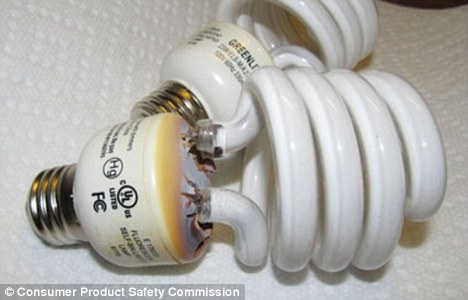Fire hazard fears over compact fluorescent lamps - after they've stopped working
-Pastor-Dale-Morgan-
Fire hazard fears over compact fluorescent lamps - after they've
stopped working
By Daily Mail Reporter
Last updated at 3:12 AM on 27th December 2011
Compact fluorescent lamps, which will gradually replace traditional incandescent bulbs, are a fire hazard that could burn down your home, experts have warned.
The lamps (CFLs) use electricity to heat an element in the lamp’s base that leads the mercury vapor gas in the coils to emit light.
But when a CFL can no longer
produce light, the electronics in its base will still try to
function, sometimes
leading to overheating, smoke and fire.

Safety concerns: There have been reports of smoke coming from the bases of compact fluorescent lamps that are no longer working
Fires from the old incandescent bulbs, on the other hand, are virtually nonexistent, masslive.com reports.
The bulb ends its life when the wire filament, which produces light when electricity passes through it, burns out and breaks.
CFLs have been touted as the blub
of the future because it uses about a fifth of the power than a
regular bulb and have a life six to 10 times as great.
Traditional bulbs will gradually be phased out in the coming years.
The U.S. Consumer Product Safety Commission started an online complaints database in March.
So far there have been 34 complaints about CFLs emitting smoke or a burning odour and four reports of one actually catching fire.
Jennifer Mieth, Massachusetts'
Department of Fire Services spokesman, told masslive.com: 'In
2008, the state fire marshal’s office office first alerted the
fire chiefs that CFLs could smoke.
'I'm not aware of any fires that fire departments in the state have responded to that were started by CFLs, but, as a consumer, it’s a good idea to be vigilant.'
In 2009, standards were revised for materials used in the plastic housing of the base of CFLs sold in North America. But millions are still in use that were produced before the change.
Read more: http://www.dailymail.co.uk/news/article-2078885/Fire-hazard-fears-compact-fluorescent-lamps.html#ixzz1humTJa60
